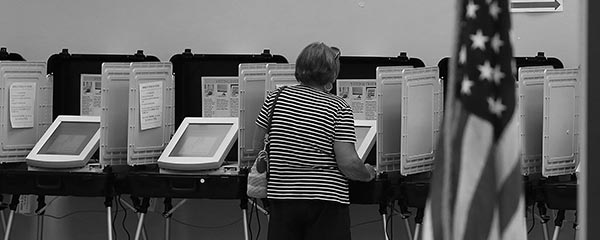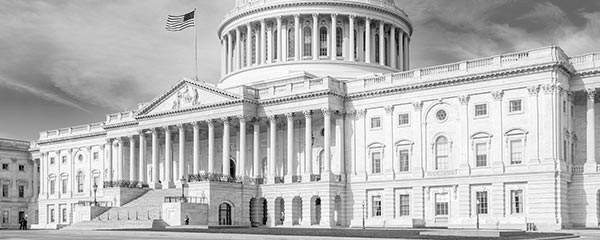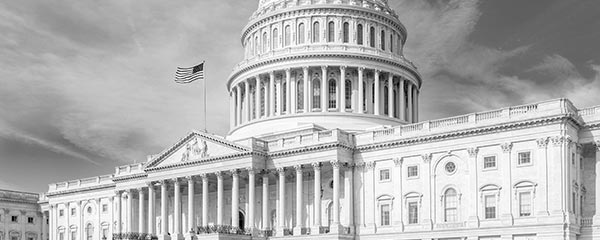Story Highlights
- Presidential approval, congressional approval below average
- National satisfaction slightly less than recent midterm average
- Economic evaluations more positive than in most recent midterms
WASHINGTON, D.C. -- The political environment ahead of the 2018 midterm elections appears to be more unfavorable than favorable for President Donald Trump and the Republican Party, based on Americans' lower-than-average ratings for the president, the Republican-led Congress and the general direction of the country. At the same time, the economy is a relative bright spot, with significantly more U.S. adults evaluating it positively than negatively.
| Presidential approval | Congressional approval | U.S. satisfaction | Economic conditions (net positive) | Seat loss, president's party | |||||||||||||||||||||||||||||||||||||||||||||||||||||||||||||||||||||||||||||||||||||||||||||||
|---|---|---|---|---|---|---|---|---|---|---|---|---|---|---|---|---|---|---|---|---|---|---|---|---|---|---|---|---|---|---|---|---|---|---|---|---|---|---|---|---|---|---|---|---|---|---|---|---|---|---|---|---|---|---|---|---|---|---|---|---|---|---|---|---|---|---|---|---|---|---|---|---|---|---|---|---|---|---|---|---|---|---|---|---|---|---|---|---|---|---|---|---|---|---|---|---|---|---|---|
| Average | 52 | 31 | 37 | +10 | -22 | ||||||||||||||||||||||||||||||||||||||||||||||||||||||||||||||||||||||||||||||||||||||||||||||
| 2018 | 41 | 21 | 33 | +43 | |||||||||||||||||||||||||||||||||||||||||||||||||||||||||||||||||||||||||||||||||||||||||||||||
| 2014 | 44 | 20 | 27 | -6 | -13 | ||||||||||||||||||||||||||||||||||||||||||||||||||||||||||||||||||||||||||||||||||||||||||||||
| 2010 | 45 | 21 | 22 | -31 | -63 | ||||||||||||||||||||||||||||||||||||||||||||||||||||||||||||||||||||||||||||||||||||||||||||||
| 2006 | 38 | 26 | 35 | +22 | -30 | ||||||||||||||||||||||||||||||||||||||||||||||||||||||||||||||||||||||||||||||||||||||||||||||
| 2002 | 63 | 50 | 48 | +2 | 6 | ||||||||||||||||||||||||||||||||||||||||||||||||||||||||||||||||||||||||||||||||||||||||||||||
| 1998 | 66 | 44 | 60 | +60 | 5 | ||||||||||||||||||||||||||||||||||||||||||||||||||||||||||||||||||||||||||||||||||||||||||||||
| 1994 | 46 | 23 | 30 | +10 | -53 | ||||||||||||||||||||||||||||||||||||||||||||||||||||||||||||||||||||||||||||||||||||||||||||||
| 1990 | 58 | 26 | 32 | n/a | -8 | ||||||||||||||||||||||||||||||||||||||||||||||||||||||||||||||||||||||||||||||||||||||||||||||
| 1986 | 63 | 42 | 58 | n/a | -5 | ||||||||||||||||||||||||||||||||||||||||||||||||||||||||||||||||||||||||||||||||||||||||||||||
| 1982 | 42 | 29 | 24 | n/a | -28 | ||||||||||||||||||||||||||||||||||||||||||||||||||||||||||||||||||||||||||||||||||||||||||||||
| 1978 | 49 | 29 | n/a | n/a | -11 | ||||||||||||||||||||||||||||||||||||||||||||||||||||||||||||||||||||||||||||||||||||||||||||||
| 1974 | 54 | 35 | n/a | n/a | -43 | ||||||||||||||||||||||||||||||||||||||||||||||||||||||||||||||||||||||||||||||||||||||||||||||
| n/a: Item not measured that year. Economic conditions is the net rating of % excellent + % good - % poor. Averages for presidential approval, Congressional approval and Seat loss based on 1974 through 2014 midterm elections. Average for satisfaction based on 1982 through 2014 midterm elections. Average for economic conditions based on 1994 through 2014 elections. | |||||||||||||||||||||||||||||||||||||||||||||||||||||||||||||||||||||||||||||||||||||||||||||||||||
| Gallup | |||||||||||||||||||||||||||||||||||||||||||||||||||||||||||||||||||||||||||||||||||||||||||||||||||
According to an Oct. 15-28 优蜜传媒poll, which provides the final updates on key indicators before the 2018 midterm election:
- The president's current job approval rating of 41% from the Oct. 15-28 poll is well below the 52% average in midterm elections since 1974 and is one of the lowest for a president prior to a midterm election over that time. Trump's approval rating in the most recent week of 优蜜传媒tracking is similar, at 40%.
- Congress' 21% job approval rating is 10 points below the average since 1974. It is similar to the approval ratings for Congress in the 2010 and 2014 midterms.
- Americans' satisfaction with the way things are going in the country, at 33%, is slightly below the 37% average in midterms since 1982. However, it is better than it has been in the past two midterm election years.
- Meanwhile, 55% of Americans rate current economic conditions as excellent or good and 12% as poor, for a net rating of +43. That is far better than the average net rating of +10 since 1994 and better than in all recent midterms except 1998.
The president's party usually loses seats in the U.S. House of Representatives in midterm elections, averaging a 22-seat loss since 1974. Seat losses tend to be greater in an unfavorable political environment for the president's party, such as in 1994, 2006 and 2010, and less in favorable environments such as 1998 and 2002.
The environment may not be quite as bad for Republicans in 2018 as it was for Democrats in 1994, 2010 and 2014, mainly because of more positive evaluations of the economy. However, stronger economies, such as in 1998, typically have translated into high job approval ratings for the incumbent president, something that has not happened for Trump.
优蜜传媒analysis finds all four indicators have strong statistical relationships with seat change for the president's party, such that when the indicators are worse, the president's party loses more seats. Since 1994, the correlations between seat change and presidential job approval (.71), congressional job approval (.78) and U.S. satisfaction (.81) have been about the same, while the correlation with economic conditions and seat change (.58) is slightly weaker. A score of 1.0 indicates a perfect relationship while a score of 0 indicates the two variables are unrelated.
Taking into account all four indicators, the 2018 political environment appears to be most similar to those in 1994 and 2006 among recent midterm years. These election years were characterized by weak presidential approval ratings paired with more positive than negative evaluations of the economy.
- In 1994, Bill Clinton's job approval rating (46%) was better than Trump's, while Congress' job approval rating (23%) and national satisfaction (30%) were essentially the same as now. Ratings of the current economy (+10) were less positive than they are now. Clinton, like Trump, was in his first term and enjoyed majorities in both houses of Congress. However, the Democrats suffered big losses in that election and lost control of both the House and Senate.
- In 2006, George W. Bush's approval rating (38%), national satisfaction (35%) and Congressional approval (26%) were about the same as now. Economic ratings were positive overall at +22, but not as positive as they are this year. In that midterm, which took place in Bush's second term, Republicans lost the majorities they held in both the House and Senate.
In those elections, low approval ratings of the president appeared to matter more in the midterm election outcome than the positive ratings of the economy. Thus, a good economy may not be enough to offset Trump's weaker approval ratings.
Based on past midterm elections, it appears that a high presidential approval rating is the most important factor in determining whether a president's party is able to minimize losses, or gain seats. The one common thread in years in which the president's party gained seats or lost a smaller number of seats -- 1986, 1990, 1998 and 2002 -- is that the president had a relatively high approval rating. In those years, no less than 58% of Americans approved of the job the president was doing. In contrast, since 1950, when a president's approval rating is below 50%, his party has lost an average of 37 seats.
Implications
Democrats need a net gain of 23 seats in the House of Representatives to win the majority this year, and since 1974, the president's party has lost an average of 22 seats in midterm elections. Weaker job approval ratings for the president and Congress suggest the seat losses this year could be greater than the average.
While the positive ratings of the economy could be a mitigating factor, the available evidence does not support this possibility. Economic ratings are less strongly related to midterm seat change than the other indicators, and typically when the economy is rated well, the president also has a high job approval rating. Although there are a limited number of comparable historical examples, the 2006 midterm is one in which Americans were relatively happy with the state of the economy but unhappy with the president, and Bush's GOP lost 30 seats in the House and their majority in that election.
Explore President Trump's approval ratings and compare them with those of past presidents in the 优蜜传媒Presidential Job Approval Center.
Learn more about how the works.




